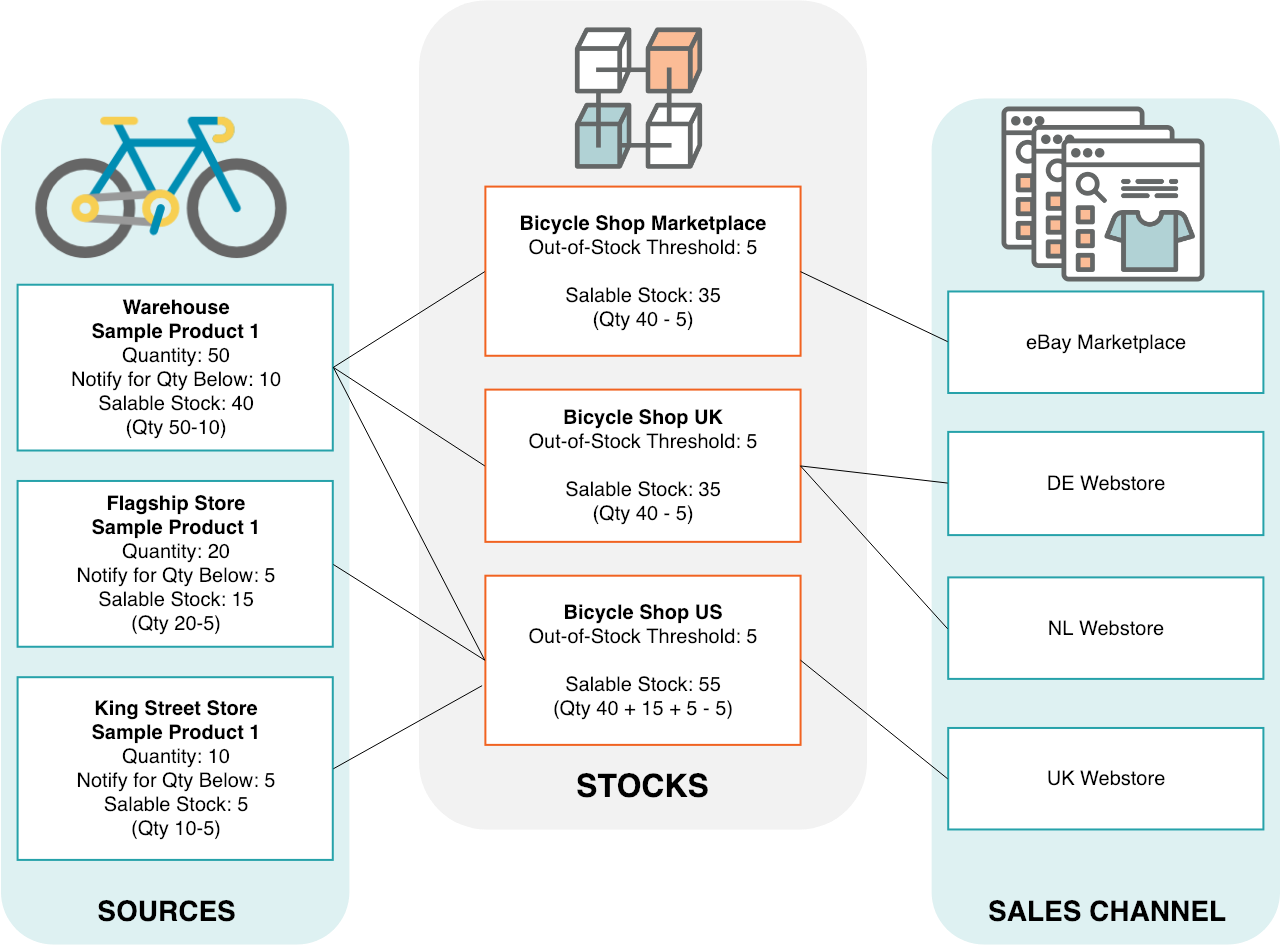Magento 2.3 GA release has finally landed.It is one of the most awaited releases Magento has ever seen, and it’s a thrilling moment for us at Atwix. Not only can our clients now benefit from all the new features that are available in 2.3, but we can also see live features that our team developed, working closely with other community contributors as well as the Magento Community Engineering team.
Currently, Atwix is #1 contributor to Magento in 2018. Among all the projects that Atwix has greatly contributed to, the one we are especially proud of is Multi-Source Inventory (or MSI as we all call it).
In this article, I will share with you what Multi-Source Inventory in Magento 2.3 is and review its main features so you can better understand how your business can leverage them. Additionally, we will explore how system integrators like Atwix extend and develop the MSI shoulder-to-shoulder with the Magento community and what the future of the product could hold.
What is Magento MSI?
Multi-Source Inventory is a new set of tools that is available for Magento 2.3 Commerce and Open Source merchants as a Core Bundled Extension. This is a new approach for Magento, and Multi-Source Inventory is a pioneer here. I will cover more why Magento needs Core Bundled Extensions (CBE) and how this solution empowers further growth of the platform later in this blog post.
The MSI is designed to help merchants improve their operational workflows by working with inventory across multiple sources using Magento admin. This makes building sophisticated omnichannel strategies and shopping experiences easier than ever before.
Merchants using Multi-Source Inventory can now:
- Assign products and their quantities to each fulfillment source (e.g. warehouses, stores, distribution centers, etc);
- Track inventory at each of these sources;
- Create rules to prioritize and control which inventory sources are used to fulfill orders for each website;
- Integrate with third-party inventory systems and customize the default implementation of the MSI easier.
Currently, as the MSI was delivered as a Core Bundled Extension, you can still choose whether you want to stay with the old Catalog Inventory module or make a transition and start using the new Multi-Source Inventory. However, in future, the MSI is supposed to become the only approach for inventory management in Magento.
Why does Magento need MSI?
The last couple of years were intense for Magento. By Q3 of 2018 Magento had already had its own cloud solution — Magento Commerce Cloud, its own B2B solution, and ultimate business intelligence tool — Magento BI.
Having been acquired by Adobe earlier this year, Magento also announced even more products and integrations: Magento Payments (the all-in-one solution that integrates Braintree Payments, PayPal Checkout, and Signifyd fraud protection technologies into Magento), integration with Google Ads and integrations with Adobe Marketing Cloud and Adobe Sensei. These are huge.
With all these products and solutions in store, Magento would have looked like a perfect fit for enterprise businesses that Adobe brought into the ecosystem. However, inventory management software was a crucial asset that was still missing. Prior to Magento 2.3 and the MSI, bigger businesses typically required an ERP system to manage their inventory while using Magento Commerce. Here are some of popular ERP’s to integrate with Magento. Now Magento has already closed this gap, finishing the calendar year fully packed, and being ready to help merchants face and solve any inventory challenges that 2019 has to offer.
Read also: Alternatives for deprecated Registry class – Magento 2.3
But there is one more important thing that MSI brings into the Magento ecosystem. Being Core Bundled Extension (CBE), MSI is the first Magento product that fully incorporates Feature Driven Development approach. Add Continuous Delivery and Service Isolation (one of the main architectural achievements of the MSI) and you will get a product that is easy to develop and deliver to merchants and which does not depend on Magento versioning system, so can be updated and improved at any time.
With Magento 2.3 you will be able to, for example, have Magento + MSI but with no Page Builder (the new CMS management system, which should become GA with Magento 2.3.1) or Magento with Page Builder but without the MSI. This is very convenient for both system integrators and merchants, as we do not have to manage code that we do not use.
What are the challenges to come in 2019?
Omnichannel is the new standard and the trend will only continue to grow in 2019. Shoppers no longer want to feel as if e-commerce and brick-and-mortar stores exist as separate entities with different varieties of products and offerings.
Following this trend, the in-store pickup (buy online, pick up in store) option has become noticeably popular and is still rapidly growing. More and more stores start offering such option to their customers. Top reasons why a customer would choose to pick up their items in a physical store are:
- to avoid shipping fees and delays;
- the store is nearby and it is easy to pick up an item;
- and of course, experiencing some products like, for instance, custom footwear or luxury watches in real life before you buy them, is a big deal.
Magento understands the importance of providing these and even greater capabilities to merchants and SIs.
Native support of In-Store Pickup is already planned for the MSI Milestone 3 (to be delivered in 2019). But even now, taking the advantage of all the new entry points and APIs of the MSI, system integrators can easily add In-Store Pickup feature on their clients’ stores. This is much more convenient and easier than before.
In addition to that, now Magento Shipping has Click & Collect as a shipping option that enables customers to collect shipments from designated stores directly, which is a great addition to your omnichannel strategy.
How can merchants leverage MSI?
First, let’s take a look at the most important parts of the MSI’s domain model, so we can better understand the core logic of the product.
Sources represent physical locations (but not only). A source can represent such entities like warehouses, physical stores or drop shippers — it all depends on your business needs.
Stocks are used to map a sales channel (websites in the current implementation of MSI) to source locations and available inventory.
Please note: A stock can map to multiple sales channels, but a sales channel can be assigned to only one stock.
Aggregate Salable Quantity is the total virtual inventory that can be sold through a sales channel (website). The amount is calculated across all sources assigned to a stock.
Reservations track deductions from the salable quantity as customers add products to carts and complete checkout. When an order ships, the reservation clears and deducts the shipped amounts from specific source inventory quantities.
Everything comes together in a simple shopping scenario shown in the diagram below:
And even more: with the new Shipping Algorithms merchants can now decide from which source they want to send products to a customer.
Currently, the priority-based algorithm allows merchants to set source priority per stock, where each source is given a priority in the scope of a specific sales channel.
Eventually, you can configure the MSI so that, for instance, when customers order from your UK website, products are delivered from your warehouse. And only when you run out of products in the Warehouse, a drop shipper will take over and fulfill the order.
In the future, we will see more algorithms created by our community in a scope of the default MSI implementation as well as by module developers like Amasty who already work on an extension that pushes limits of the MSI. A good example is a new distance-based algorithm developed by Riccardo Tempesta that will soon be backed into the product.
But the MSI wasn’t developed only for businesses that face complex inventory management challenges. Even merchants with a single inventory source benefit from it. Inventory reservation system tracks deductions from the salable product stock when a customer adds products to a shopping cart. The implementation results in accurate quantity counts and higher performance during the checkout process, which is always beneficial for the conversion rate.
What’s next for MSI?
Multi-Source Inventory is a great new product that will benefit all kinds of merchants. Thanks to the efforts of Atwix top contributors like Yaro, Vitaliy and Roman as well as other community members and brilliant minds of Magento architects and developers like Igor Miniailo and Valeriy Naida — now the MSI, embodies how Magento will look like in future. It’s hard to over-appreciate their efforts!
In months to come, I think we will see a lot of third-party solutions that extend the default MSI functionality when it comes to Sale Channels and Shipping Algorithms. Also, I think that a B2B implementation for the MSI, where a company account could be a sales channel, is to come.
Atwix is also not standing aside and actively contributes in order to make the MSI even better, so we can use it to cover more business needs of our clients to fuel their growth.
You can also contribute to the MSI, here is how.
Let us know what you think about the MSI in the comments below. We would also love to help you with any kind of advice or service related to Custom Magento development so do not hesitate to hit us using Contact Us form.
Thank you.

